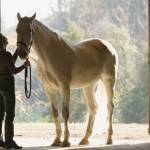Caring for Horses After Riding

Just as you go through a series of steps—grooming, tacking up, some initial minutes of easy walking and trotting—to begin a ride, you also need to pay attention to the same things, but in reverse order, after finishing your riding session.
Following a trail ride, dressage lesson, or a jumping school, your horse needs time to relax and cool down before you put him away for the day. Make a habit of walking for the last five to fifteen minutes of your ride (less after an hour-long lesson, more after a several-hour trail ride). There are several reasons for this. A period of walking is a release for the dressage horse or jumper that has probably worked hard for an hour while followed near-constant signals from the rider. Walking on a loose rein is a chance for the horse to stretch its back and neck and bring pulse rate and respiration down toward normal levels. For trail horses that may have climbed hills, forded streams, and done hours of trotting and cantering, an easy walk allows them to cool down gradually. By walking the last couple of miles on the return leg of the trip, you also avoid reinforcing the dangerous tendency of some horses to pull, jig, or race back to the barn. Always offer water after you dismount and periodically during the first half-hour or so after your ride.
Once you dismount, loosen the girth or cinch a bit and walk the horse to its stall or tie ring. Remove the bridle and replace it with a halter and lead shank if you are going to walk the horse or tie it up. Never tie your horse by the reins! Once the horse is secured, rinse the bit off, wipe off obvious sweat and dirt from the saddle and girth, and place the tack out of the way. You’ll clean everything later, but this immediate care will save time in the long run.
Going over the horses as you groom before the ride ensures that you start out with a clean horse that has no obvious injuries. Grooming after the ride is a little different—most likely you won’t brush as much—but it serves the same purpose. You may need to hose the horse’s legs and belly to remove dirt. If the horse is sweaty, you can sponge the saddle and girth areas or bathe the entire horse if necessary. On a hot day, the horse will probably enjoy an all-over hosing even if he’s not terribly sweaty. Hosing with cold water will help to cool the horse’s body, but you may still need to walk him and be sure he’s cooled out and breathing normally before putting him in the stall or pasture.
Part of after-ride grooming is examining every part of the horse to check for problems. Look for rubs or chafing from the bridle, saddle, girth, and other tack. Run your hands down the horse’s legs to feel for cuts, bumps, or rubs from boots. Pick out his feet and check that his shoes are in good condition. Watch him stand and walk, noting whether he’s bearing weight equally on all legs and is moving freely.
When the horse is cooled out after a long or hard work session, let him have at least 15 to 30 minutes of free turnout in a paddock, if possible, before putting him in a stall. This will allow the horse to get another drink, eat a little grass, roll, and move around without weight on his back. You can also check him for any sign of colic, lameness, or “thumps” (synchronous diaphragmatic flutter, a sign of electrolyte imbalance) before leaving him.
Grass and hay can be offered soon after the ride, but wait at least an hour after serious exercise before feeding grain. Splitting the horse’s evening meal into two smaller quantities and feeding them several hours apart is a good idea after a long day of riding.
The day after an unusually long or hard ride, you and your horse may both experience some stiffness and muscle pain from unaccustomed exercise. Turnout rather than stalling will lead to less stiffness. If you and your horse are extremely stiff and sore, reconsider your horse’s fitness program and plan for a longer stretch of training and conditioning before your next long day in the saddle.








